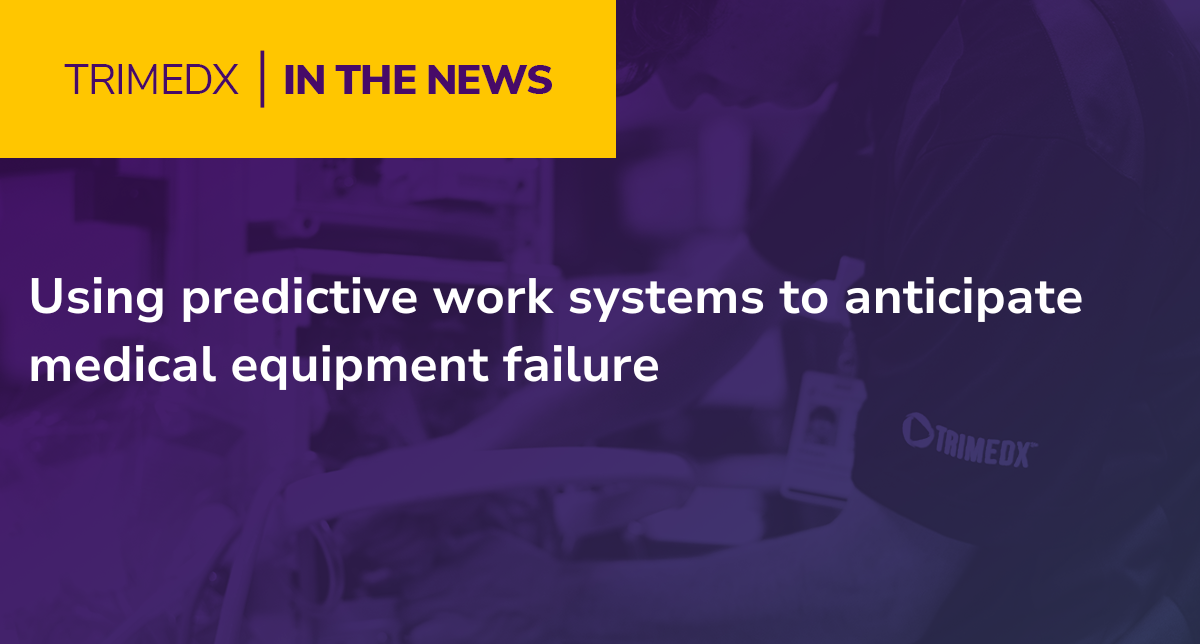TRIMEDX President of Clinical Engineering Rob Moorey recently contributed an article to 24x7 Magazine (May 2, 2024), Healthcare Business Today (May 6, 2024), and Quality Digest (May 20, 2024) about how health systems can strengthen the connection between technology and expertise to predict medical equipment failures before they occur and reduce unplanned downtime. The full article, as it appeared, is below.
Summary: Leveraging advanced technologies like predictive work systems, real-time location systems (RTLS), and artificial intelligence (AI) helps healthcare organizations proactively prevent equipment failures. These tools enhance predictive maintenance, streamline equipment tracking, and improve diagnostic accuracy, leading to improved patient care and reduced costs for healthcare systems.
Key Takeaways:
- Predictive Maintenance: Predictive work systems help identify equipment issues early, reducing unexpected breakdowns.
- Efficient Tracking: RTLS improves equipment tracking and maintenance efficiency, reducing search times.
- Data-Driven Insights: AI provides actionable insights for optimizing equipment performance and minimizing disruption to patient care.
Equipment failures in healthcare can have serious consequences, including delays in diagnosis or treatment, scheduling disruptions, and patient safety risks. Health systems should empower clinical engineering teams with technology that helps proactively identify potential failures.
This will allow health systems to gain visibility into the performance of their equipment and take action to prevent failures before they occur. Avoiding equipment failures leads to shorter turnaround times for maintenance, fewer disruptions to patient care, improved patient safety, and reduced stress for BMETs.
Benefits of Predictive Work Systems
Health systems can significantly decrease the number of unforeseen equipment breakdowns by providing BMETs with predictive work systems. This advanced technology combines remote device monitoring, service expertise, and data science to recognize common preventable equipment problems before a failure happens.
For example, an MRI could be losing helium without anyone realizing it. If this were to continue, the magnet could reach a critical point resulting in quench and significant unplanned downtime, as well as lost revenue and impacted patient care. A predictive work system would alert technicians that the helium is approaching a critical level, allowing them to take preventative actions and schedule planned downtime that’s convenient for clinicians and the clinical engineering team.
A predictive work system could also analyze conditions that indicate air bubbles are developing within a CT machine, even when it appears to be working normally. This is a problem that can typically be difficult to anticipate. However, a predictive work system can notify BMETs there is a problem before it interferes with patient care.
Improving Preventative Maintenance with RTLS
An effective way to streamline preventative maintenance is by taking advantage of Real-Time Location Systems (RTLS). Regular preventative maintenance is one of the most reliable ways to lessen the risk of equipment failures and reduce costs, but clinical engineering teams can struggle to keep track of large, complex, and mobile equipment inventories. An RTLS allows BMETs to know exactly where devices are located, find them, and perform the needed preventative maintenance.
The RTLS will reduce the time spent searching for a device and increase the number of preventative maintenance tasks they’re able to complete each month. TRIMEDX has found that an RTLS can reduce the time spent searching for devices by up to 50%. Without that capability, if a BMET hasn’t been able to find a device to service it, the device could fail when a clinician tries to use it on a patient. This may lead to disrupted scheduling and clinician and patient frustration.
Automation in Equipment Testing
Traditionally BMETs have relied on pen and paper to record equipment test results. After running the tests, they compare the written results to acceptable limits and enter the results manually into a database. This process is time-consuming and filled with opportunities for human error, resulting in incorrect readings, unexpected equipment problems, or issues that could negatively impact patient care and safety.
If BMETs have the latest technology, they can instead run tests through a mobile app that automatically feeds results into the system. The app can eliminate handwritten documentation, quickly validate that results are within permissible limits, and allow technicians to complete proactive maintenance at the time of testing. When equipped with this type of technology, health systems will see fewer incorrect test results and improved failure diagnostics, data handling, and compliance reporting.
Leveraging AI for Enhanced Equipment Performance
There are many ways artificial intelligence (AI) can empower clinical engineering teams to proactively avoid equipment downtime. Automated equipment testing can also collect valuable data. Machine-learning engines can then collect and analyze the vast amounts of data generated during testing to continuously improve testing accuracy. This process ultimately helps minimize unforeseen failures and ensures equipment is consistently in working order.
By adding machine-learning tools to their toolbox, health systems can have access to real-time data and analysis about their clinical assets. By contrast, in the time a health system manually analyzes data about equipment usage, part replacement, and failure diagnostics–that data is likely out of date. Manually analyzing such large amounts of data is time-consuming and expensive. AI can collect and analyze data in real-time, giving health systems more visibility into equipment performance and allowing them to make smarter decisions.
AI also allows technicians to optimize their preventative maintenance to keep equipment and devices up and running while minimizing interference with patient care. If a certain part needs to be replaced on a machine, AI-powered systems could warn the BMET there is a high probability another part will need to be replaced within three weeks. This allows the BMET to order and replace both parts at the same time, instead of working on the machine twice in a matter of weeks.
Conclusion
By strengthening the connection between technology and BMET expertise, health systems can avoid costly equipment outages and reduce the stress on overworked technicians. An expert clinical engineering team armed with the latest technology will improve patient care and safety while producing cost-savings for the health system.
